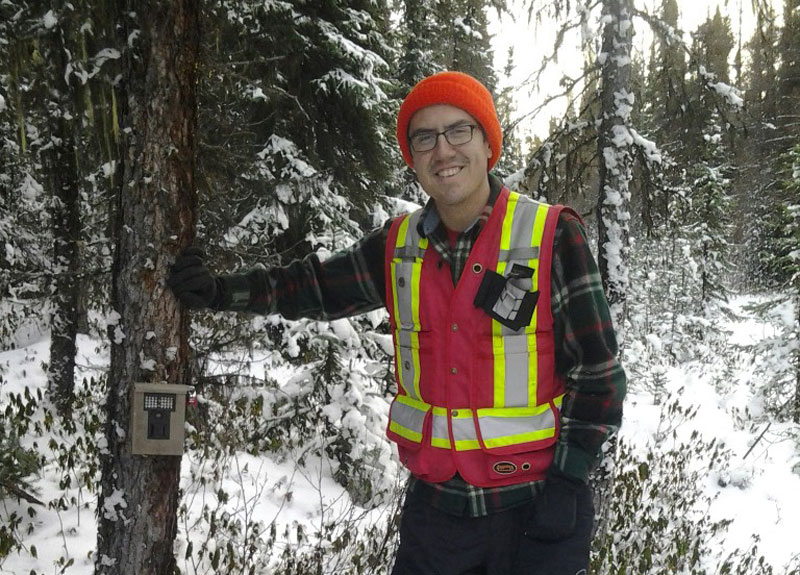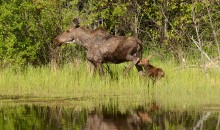
Assessing Pathogen Prevalence and the Health of Ungulates in West-central Alberta Caribou Ranges
This project will gather data on the disease and parasites carried by moose, deer, and elk to determine the risk of transmission to caribou.
Land managers need to know the threats faced by caribou in order to conserve declining populations. Landscape disturbance is creating greater overlap between caribou ranges and other ungulates such as moose, deer, and elk. This could potentially increase the risks of transmitting diseases and parasites to caribou, reducing survival and reproduction.
To help collect ungluate samples, the Caribou Program is providing sample kits to hunters in west-central Alberta. These samples will be tested for pathogens to determine their presence, abundance, and location to identify potential sources of disease outbreaks in caribou.
Caribou Health
Health contributes to the survival and reproductive success of individuals in free ranging ungulate populations. Certain pathogens kill ungulates directly, while others have more subtle chronic effectssuch as compromised immunity, and reduced body condition. In turn, these effects can contribute to population declines through increased predation risk, reduced pregnancy rates, low calf survival and juvenile recruitment, or by diminishing the ability of affected animals to cope with natural or anthropogenic stressors including severe weather and industrial development.
The relative importance of health as a driver of ungulate population performance will likely increase with climate change and increased overlap of different ungulate species. Within small or fragmented populations of ungulates, there is also an increased risk of compromised health, disease transmission, and catastrophic disease outbreaks. For caribou, disease transmission from sympatric ungulate species such as moose, deer, and elk may also lead to disease-mediated apparent competition and as the range and density of other ungulate species expand within early seral landscapes—the result of anthropogenic activities across caribou ranges—the risk of disease transmission to caribou may increase.
Since 2013, the British Columbia Boreal Caribou Health Program has identified pathogens and parasites including winter tick, Erysipelothrix rhusiopathiae, and Neospora caninum in live captured and dead radio collared caribou that may be shared with other ungulates. The same pathogens have been recorded in a small sample of unexplained (non-predator related) caribou mortalities assessed by the fRI Research Caribou Program from 2013–2015.
Pathogens
Winter tick (Dermacentor albipictus), is an ectoparasite typically associated with moose. In moose populations, winter tick has been linked to poor body condition, reduced reproduction, and even significant die-offs of up to 30% of the population.
E. rhusiopathiae is a multi-host bacterial pathogen recently found to be associated with large-scale mortality events in muskoxen in the Canadian Arctic Archipelago.
Neospora caninum is a protozoan parasite that can infect a wide-range of hosts and has been found to be a major cause of abortions in cattle.
These emerging pathogens may represent a distinct threat to the health status and sustainability of caribou in Alberta. However, without baseline data on these and other potential pathogens in ungulates within caribou ranges, it is impossible to determine the sources of exposure in caribou and the potential effects that these pathogens and parasites may have on caribou populations.
Previous Research
To date there has been little focus on the health status of caribou in Alberta. As caribou are listed as a protected species at the provincial and federal level, and given that caribou are not hunted in Alberta, the full range of biological samples required to develop herd health baselines are not readily available. However, the more abundant ungulates (moose, deer and elk) that are hunted within caribou range provide an opportunity to proactively monitor the diversity and prevalence of pathogens shared with caribou.
Study Area
The main study area is the Grande Cache area within the Narraway, Redrock-Prairie Creek and Little Smoky caribou ranges. However samples collected by hunters in the surrounding region are still of value to this project. The surrounding region includes: Hinton, Edson, Grande Prairie, Valleyview, Fox Creek and Whitecourt.

Objectives
The overall purpose of this project is to establish a health baseline for ungulates that occur within caribou ranges in west-central Alberta. This baseline information can be used to identify ungulate populations that may be at risk from cross species disease transmission, and establish health baselines in ungulate species that may be used to track future changes under alternate scenarios (i.e. climate change, and habitat fragmentation) and to identify areas where caribou could be affected by pathogen-mediated apparent competition (disease transmission).
The project has the following objectives:
- Identify pathogens from blood and hair samples collected from ungulates (moose, deer, and elk) harvested in caribou ranges.
- Establish partnerships and a monitoring framework to continue health monitoring of ungulates into the future.
- Investigate the spatio-temporal prevalence of pathogens in relation to landscape conditions (anthropogenic and natural disturbance), protected areas, and ungulate species distribution to assess the risk of disease transmission from moose, deer, and elk to sympatric caribou populations.
Sample kits distributed for hunting season.
Citizen scientists submit hair and blood samples from ungluates.
Citizen scientists submit hair and blood samples from ungluates.
Samples submitted to lab, data analysis begins.









